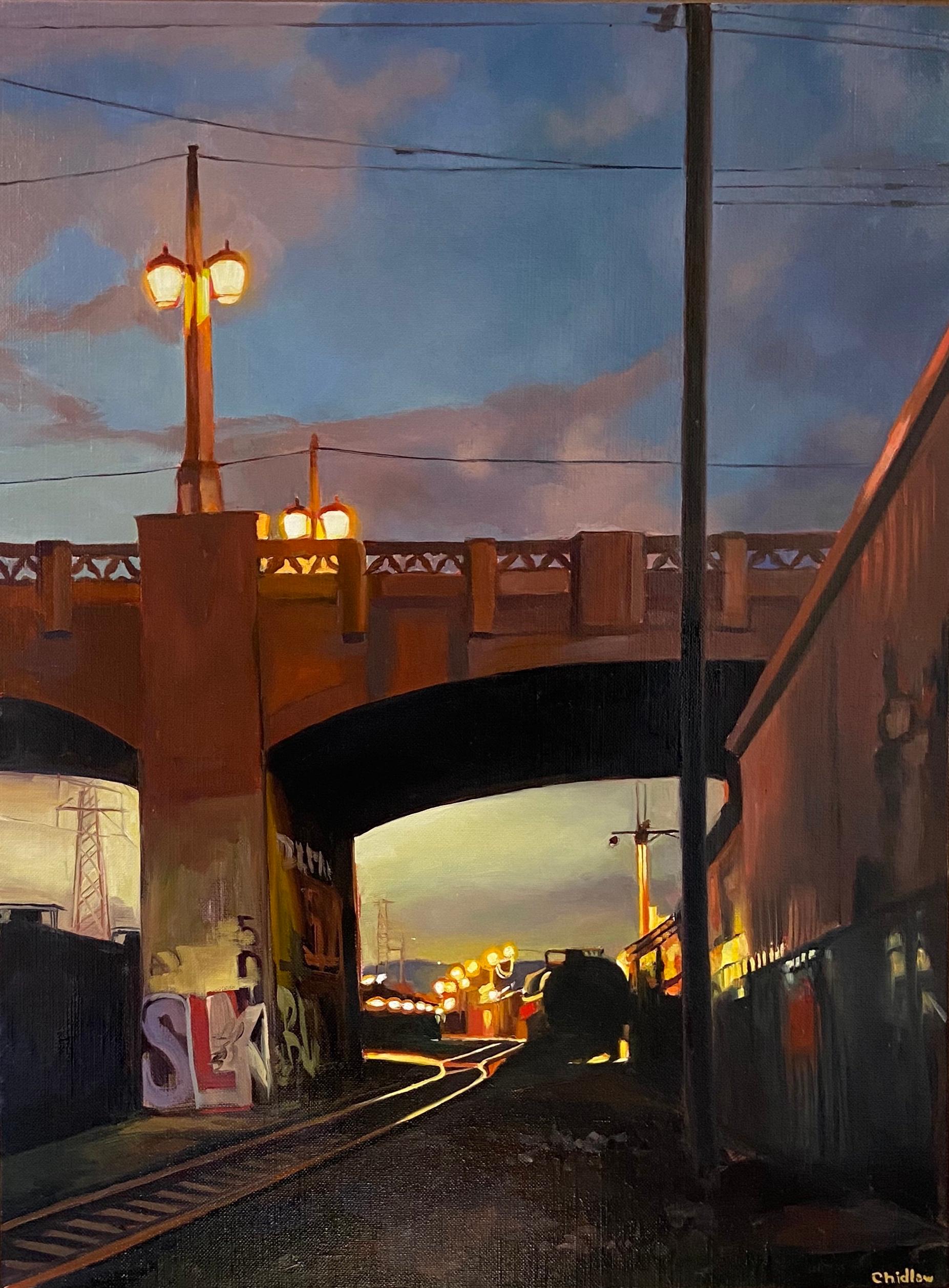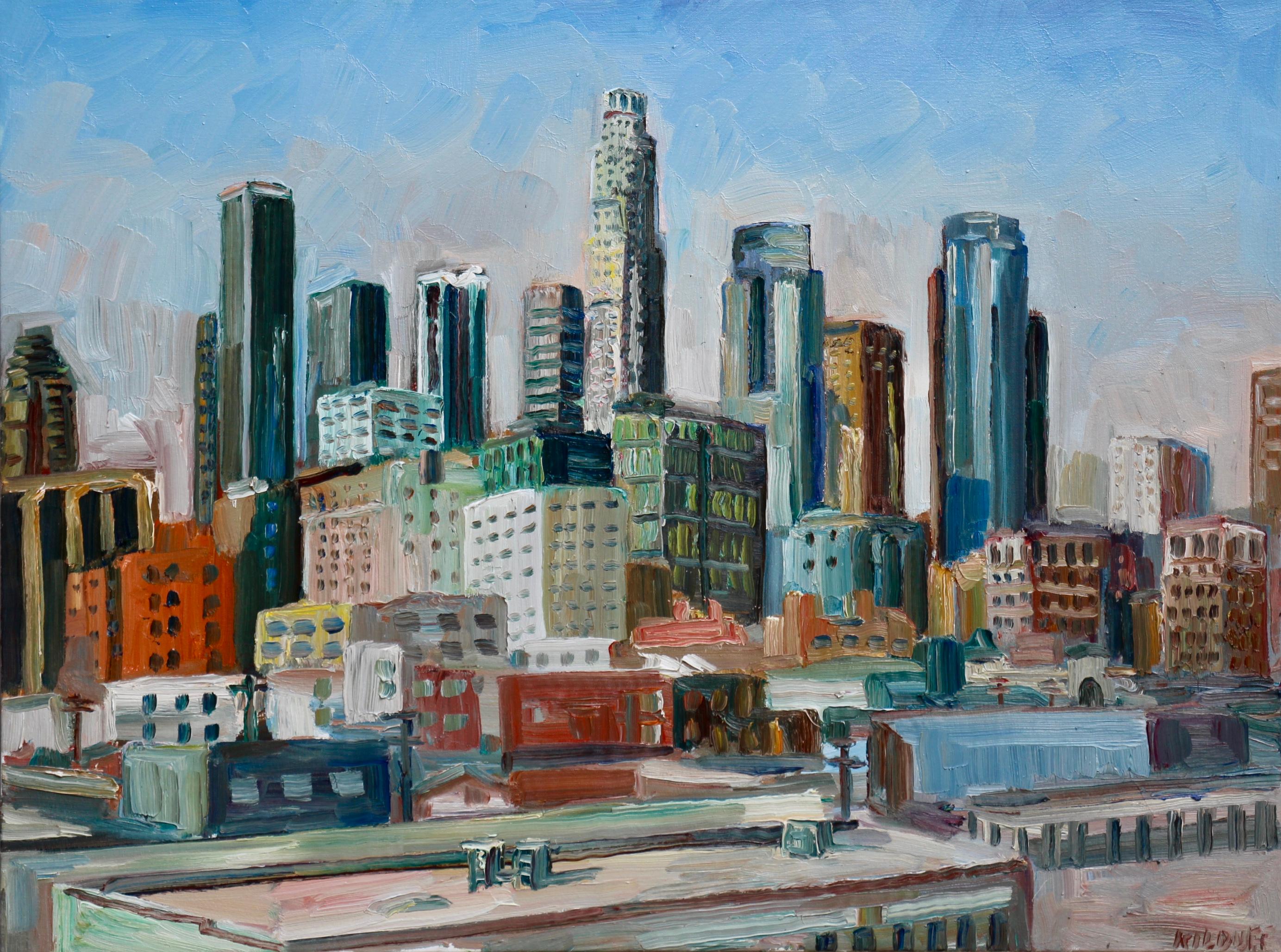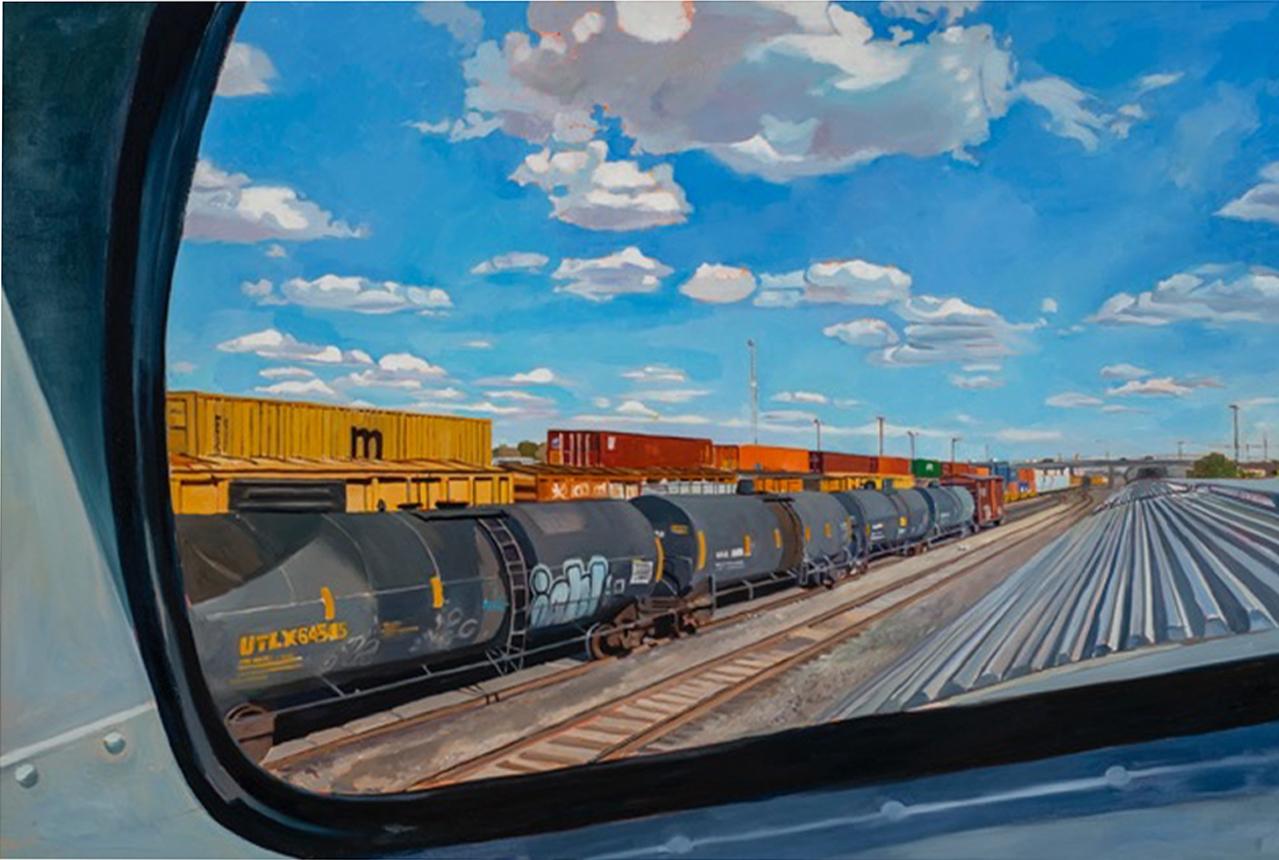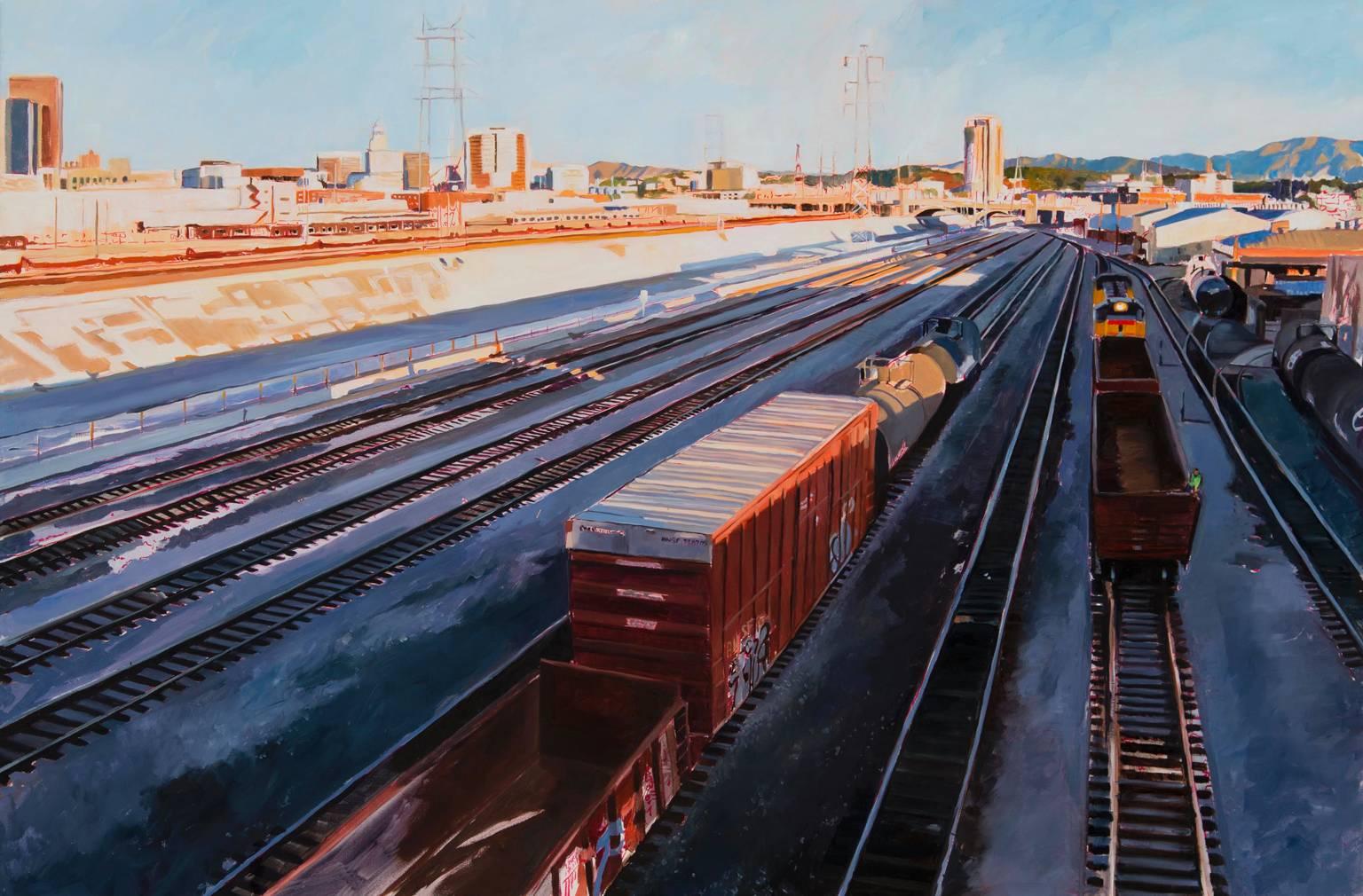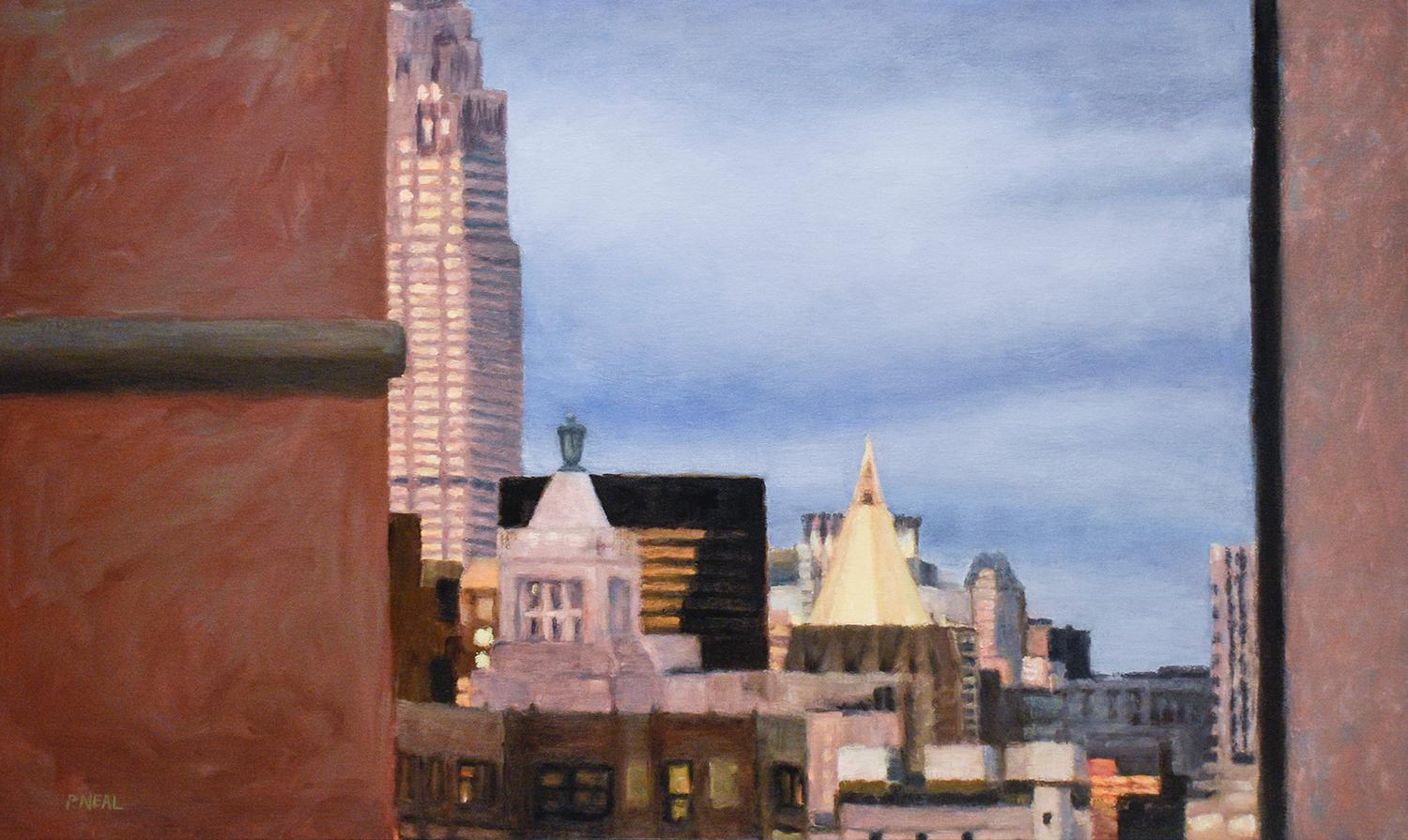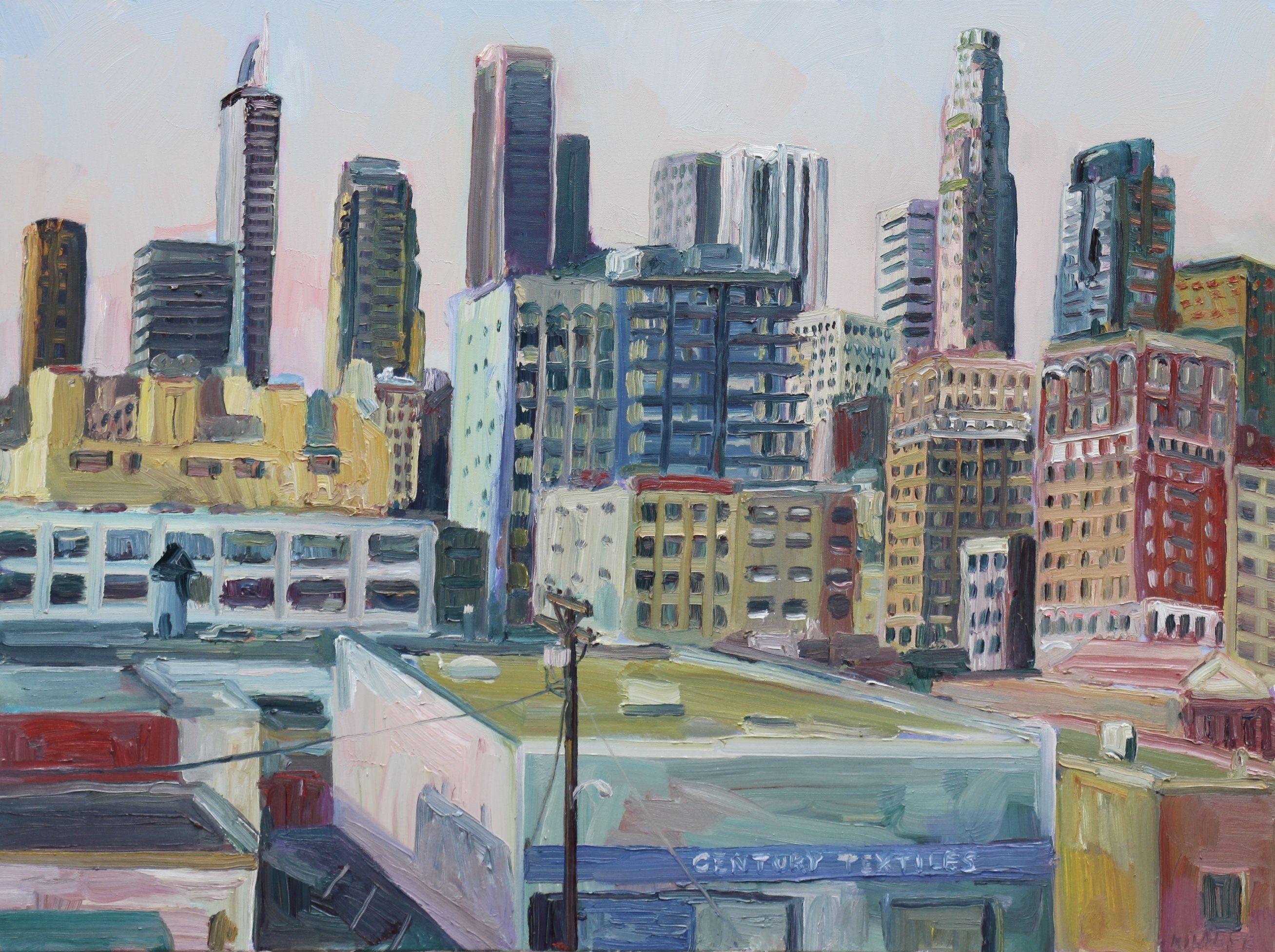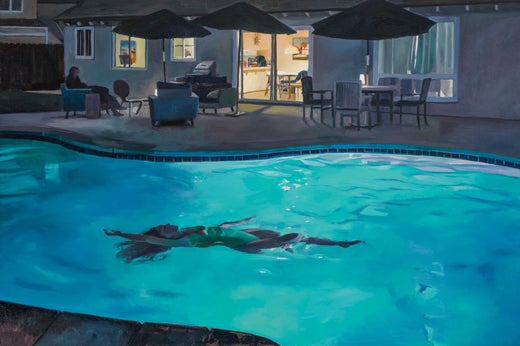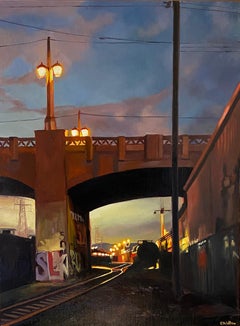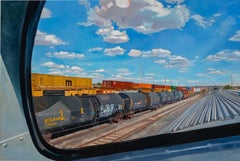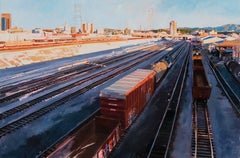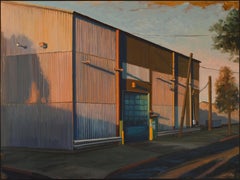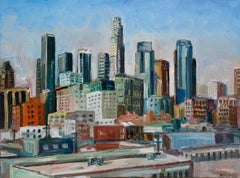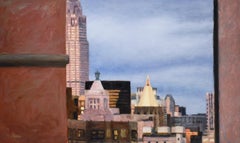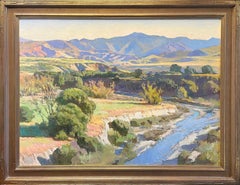Items Similar to View from the Train, L.A. River
Want more images or videos?
Request additional images or videos from the seller
1 of 5
Patricia ChidlawView from the Train, L.A. River
$9,000
£6,985.70
€7,959.07
CA$12,861.98
A$14,007.66
CHF 7,385.75
MX$170,373.59
NOK 92,875.52
SEK 87,109.64
DKK 59,432.67
About the Item
Represented by George Billis Gallery, NYC & LA --When asked what kind of paintings I make, I usually call my work "Urban Landscapes" to distinguish them as paintings about areas of human habitation rather than landscapes that reference the natural world. But my subjects are certainly not all urban – some are suburban, some small towns and some are ruins, such as a faded sign and abandoned business bleaching in the desert sun as once populated areas return to their former empty silence. While I often treat older architectural forms, I want to make it clear these are not paintings about nostalgia – all are contemporary scenes, recently observed. Currently I've painted a number of pictures which seem neither urban nor rural but are set in that particular non-space that now covers so much of the landscape – the limbo of freeway exits and on-ramps and their attendant fast-food franchises.
What I feel these mostly unpopulated places I choose to paint have in common is a potency, some kind of emotional charge that enables them to function as settings for a subjective fictional narrative. As the artist I choose and edit the scenes, setting the stage for viewers to bring their imaginations and private meanings to these places made special by my selection and attention."
Notes: Los Angeles, Urban, City, LA, River, Overpass, Graffiti
Colors: Blue, Green, Grey
- Creator:Patricia Chidlaw (American)
- Dimensions:Height: 36 in (91.44 cm)Width: 24 in (60.96 cm)
- Medium:
- Movement & Style:
- Period:
- Condition:
- Gallery Location:Fairfield, CT
- Reference Number:1stDibs: LU18321542313
Patricia Chidlaw
Painter and art critic Wyndam Lewis wrote “Art is the expression of an enormous preference.” We gravitate to the visual based on what appeals to us deep in our souls. That preference is such a personal and complicated response to countless factors - and not something easy to quantify. Patricia Chidlaw’s preferences - what she find visually engaging and beautiful - have stayed remarkably consistent over her forty years of painting. The morning light on the stark pavement of the L.A. River still takes her breath away. She is drawn to those older parts of cities - the forgotten alleys and underpasses. And yet these very spaces she finds so compelling are vanishing at an ever increasing speed as cities evolve and modernize. When asked what kind of paintings she makes, Chidlaw describes them as "urban landscapes” but her subjects are certainly not all urban – some are suburban, some are rural small towns, and some are ruins, such as a faded sign and abandoned business bleaching in the desert sun as once populated areas return to their former empty silence. While she often depicts older architectural forms, it is clear that these are not paintings about nostalgia – they are all contemporary scenes, recently observed. Chidlaw is endlessly attracted to light - to the changing light of the morning and evening, to how shadows play over Los Angeles, to the subtle shades of color in the sky and how that playings over clouds. And while natural light is a huge influence, Chidlaw is deeply drawn to the concrete and steel of the constructed world. Chidlaw writes of her explorations for this new series, “I have had a few recent visual surprises - who knew swimming pools would become illuminated with L.E.D. lights, that can segue through the entire color spectrum. In these places I have chosen, I think the attraction goes beyond the particulars of of patterns of light and dark and color to the emotions these places evoke for me.” When an artist chooses to make a painting of a particular place, the message is “I find this to be important” and in depicting that space, guides the viewer to find what the artist herself is so drawn to. Chidlaw encourages us to take a second look at the spaces we so often drive past - to stop and revel in the angles of bridges, the shadows falling across a cityscape, the vistas framed by unexpectedly elegant power lines - to take that moment and find the hidden beauty of these urban landscapes. Patricia Chidlaw received her BA from the University of California, Santa Barbara and has exhibited extensively on the West Coast and at numerous art fairs throughout the US. In 2014, she was the subject of a solo exhibition, Realm of the Commonplace - Paintings by Patricia Chidlaw, at the Nevada Museum of Art in Reno, NV. Her work appears in many private collections and has been featured in THE Magazine, ArtScene, Southwest Art, Artweek, and on KCET.
About the Seller
5.0
Vetted Professional Seller
Every seller passes strict standards for authenticity and reliability
Established in 1996
1stDibs seller since 2015
264 sales on 1stDibs
Typical response time: 7 hours
- ShippingRetrieving quote...Shipping from: Los Angeles, CA
- Return Policy
Authenticity Guarantee
In the unlikely event there’s an issue with an item’s authenticity, contact us within 1 year for a full refund. DetailsMoney-Back Guarantee
If your item is not as described, is damaged in transit, or does not arrive, contact us within 7 days for a full refund. Details24-Hour Cancellation
You have a 24-hour grace period in which to reconsider your purchase, with no questions asked.Vetted Professional Sellers
Our world-class sellers must adhere to strict standards for service and quality, maintaining the integrity of our listings.Price-Match Guarantee
If you find that a seller listed the same item for a lower price elsewhere, we’ll match it.Trusted Global Delivery
Our best-in-class carrier network provides specialized shipping options worldwide, including custom delivery.More From This Seller
View AllGraffiti and Tank Car
By Patricia Chidlaw
Located in Fairfield, CT
"When asked what kind of paintings I make, I usually call my work "Urban Landscapes" to distinguish them as paintings about areas of human habitation rather than landscapes that refe...
Category
2010s American Realist Landscape Paintings
Materials
Canvas, Oil
View from Vista Dome
By Patricia Chidlaw
Located in Fairfield, CT
Represented by George Billis Gallery, NYC & LA -- "When asked what kind of paintings I make, I usually call my work "Urban Landscapes" to distinguish them as paintings about areas o...
Category
2010s American Realist Landscape Paintings
Materials
Linen, Oil
Freight Train in Shadow
By Patricia Chidlaw
Located in Fairfield, CT
Represented by George Billis Gallery, NYC & LA -- Chidlaw is an American realist seeking, and finding, profundity in the realm of the commonplace. She takes aims at dignity and a dur...
Category
2010s American Realist Landscape Paintings
Materials
Canvas, Oil
Building No. 41
By Sharon Feder
Located in Fairfield, CT
Represented by George Billis Gallery, NYC & LA -- Humanity is archival, like the strata that compose the earth. Our structures and art, superfund sites to cathedrals, exist because o...
Category
2010s American Realist Landscape Paintings
Materials
Oil, Panel
Trainyard No. 12
By Sharon Feder
Located in Fairfield, CT
Represented by George Billis Gallery, NYC & LA -- Humanity is archival, like the strata that compose the earth. Our structures and art, superfund sites to cathedrals, exist because o...
Category
2010s American Realist Landscape Paintings
Materials
Oil, Panel
La Campagna
By Nicholas Evans-Cato
Located in Fairfield, CT
Represented by George Billis Gallery, NYC & LA --Every painting begins with a place to stand. Sometimes I find one in seconds; sometimes the hunt goes on for many seasons. A canvas c...
Category
21st Century and Contemporary American Realist Landscape Paintings
Materials
Linen, Oil
You May Also Like
Downtown LA view from 12th and San Pedro
By John Kilduff
Located in Yardley, PA
Painted on on the rooftop parking lot (12th and San Pedro) overlooking Downtown Los Angeles. :: Painting :: Impressionist :: This piece ...
Category
2010s Impressionist Paintings
Materials
Oil
View from the Train: Cityscape Oil Painting, View of Brooklyn
By Patty Neal
Located in Hudson, NY
View from the Train, 2019
24" X 40" x 1", oil on canvas
This contemporary oil painting depicting a metropolitan view is the work of realist painter Patty Neal. The painting offers an intimate view of the city, as seen from a window, as it peeks from behind two metal structures. The dark browns and bright golds beautifully compliment the dusty blue, gray sky. Neal works highlight everyday city scenes, utilitarian infrastructure, and industrial or electrical apparatus.
Artist statement:
A life is an accumulation of experiences: visual, emotional and mental. By compartmentalizing these snippets of life we create boundaries. The focus of my work for many years has been the exploration of these various life aspects and how they are bound together or bound from each other. My process is often literally composed of boundaries. I make a painting by putting together multiple panels, or I segment a single panel into separate visual spaces. The works are made up of pieces or elements of city and landscape. While exploring the concepts of boundaries I play with visual “reality.” Sometimes I combine images that are upside down with those that are not and juxtapose images from different contexts. Literal boundaries, such as walls fences, expanses of water and highway median strips are also used. My intent is to invite viewers to look beyond these boundaries to see the possibilities of a connected whole.
About the artist:
Solo Exhibitions
2011 "Interior/Exterior", Carrie Haddad Gallery, Hudson, New York
2008 ”Landscape Revisited”, 1870 Gallery, Belmont
2005 Nomad Rug Gallery, San Francisco
2004 "Landscapes"@Klein's, San Francisco
2004 "Landscape Renewed," Space 743, San Francisco
2003 Exploding Head...
Category
2010s Contemporary Landscape Paintings
Materials
Oil, Wood Panel
Downtown Los Angeles Rooftop View, Painting, Oil on Canvas
By John Kilduff
Located in Yardley, PA
Plein air oil painting from a rooftop overlooking Downtown Los Angeles. :: Painting :: Impressionist :: This piece comes with an official certific...
Category
2010s Impressionist Paintings
Materials
Oil
California Light, San Juan Creek
By Ray Roberts
Located in Pasadena, CA
Acquired by the gallery directly from the artist
UNFRAMED: 30" x 40" FRAMED: 36.5" x 46.5" x .5"
Artist Statement
"The watershed for Mission San Juan Capistrano remains mainly undeveloped and offers an uncommon view of the native beauty of the Southern California coastal range. Sycamore groves studding the landscape offer a golden touch to the arid landscape; a harmony of land and color."
— Ray Roberts
Category
2010s Realist Landscape Paintings
Materials
Oil, Panel, Linen
Painting of Sunset in Los Angeles California USA by British Landscape Artist
By Angela Wakefield
Located in Preston, GB
Painting of Sunset in Los Angeles California USA by British Urban Landscape Artist, Angela Wakefield. This painting is on high quality art board, p...
Category
2010s Contemporary Landscape Paintings
Materials
Paint, Acrylic, Board, Gesso, Mixed Media, Oil
Trackside on 24th overlooking Sloss and #280
Located in Denver, CO
Trackside on 24th overlooking Sloss and #280, 2020
Category
21st Century and Contemporary Figurative Paintings
More Ways To Browse
Modern Southwest Art
Mountain Landscape Sierra
Oil Painting Ra
Painting 14th Century
Paintings Of Canyons
Palette Knife Painting Acrylic
Rob Browning Art
Robert Kenneth White
Rowing Painting
Rural America Painting
Sanne Bleka
Sidney Goodman
Summer Reflections
1980 Russian Painting
Beach Umbrella Painting
Boat Mast
Bordeaux Painting
Caspar David Friedrich
